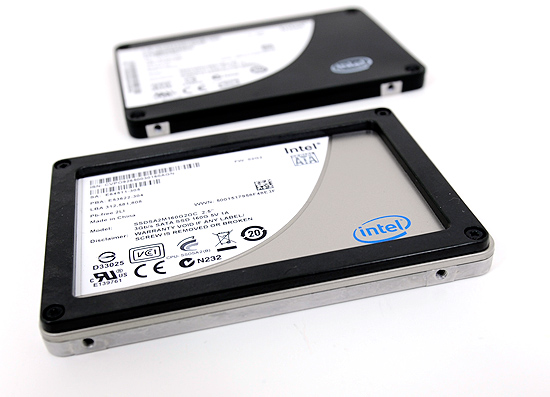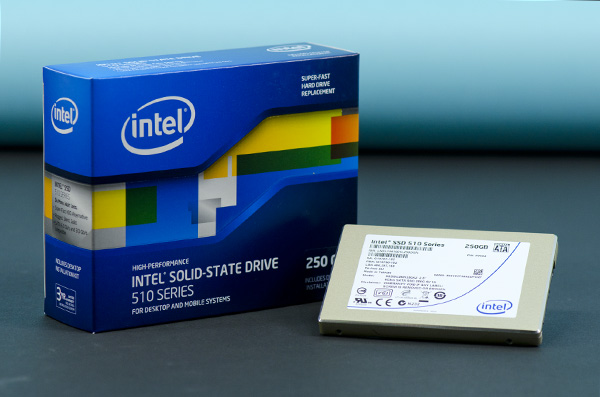The Intel SSD 510 Review
by Anand Lal Shimpi on March 2, 2011 1:23 AM EST- Posted in
- IT Computing
- Storage
- SSDs
- Intel
- Intel SSD 510
The X25-M was a tremendous first attempt by Intel to get into the SSD market. In our review of the SSD I wrote that Intel just Conroe’d the SSD market, and if it weren’t for the pesky 80MB/s sequential write speed limitation the X25-M would’ve been given the title: World’s Fastest Drive.

Its successor, the X25-M G2, was a mild update that brought prices down through the use of 34nm NAND. Remember that Intel is also 49% owner of the IMFT joint venture and as a result can be quite competitive on NAND pricing (and quite early to adopt new NAND technologies).

Intel’s goal all along was to drive down the cost of SSDs. Looking at the history of MSRPs with the X25-M (not to mention the M, which stood for Mainstream in the product name) this shouldn’t come as a surprise:
| Intel X25-M Pricing History | |||||
| 2008 | 2009 | ||||
| 40GB | - | $125 | |||
| 80GB | $595 | $225 | |||
| 160GB | $1000+ | $440 | |||
The third generation X25-M was to drive down costs even further, this time thanks to Intel’s 25nm NAND. You’d be able to get twice the capacity at the same price point as the X25-M G2. The value drive would be an 80GB offering, the mainstream drive would be 160GB and the high end drive would be 320GB.
The drive would offer higher performance. The controller was to be completely redesigned, with the “oversight” that limited sequential write speed to only 100MB/s corrected entirely. In addition, the third generation Intel SSD would add full disk encryption - making it even better suited for enterprise customers. Going after the enterprise market was Intel’s plan to really make money on SSDs in the long run. Instead of just selling corporations a CPU, chipset and wireless controller in a notebook, there would be an SSD on top of all of that. Perhaps eventually even have some security software courtesy of McAfee.
The third generation X25-M was originally due out in the middle of 2010. As is usually the case with schedules, the “G3” slipped. The middle of the year became the end of the year and the end of the year became Q1 2011.
To make matters worse, the specifications Intel was talking about for its third generation drive/controller weren’t all that competitive. We published the details last year knowing that the competition would do better. Intel’s redesigned controller was late and underperforming. Internally, Intel knew it had a problem.
Intel aimed for the majority of the market with the X25-M, it had set its sights on lowering cost, but it left the high performance enthusiast market entirely uncared for. A void that SandForce filled quite nicely with its unique brand of controllers.
With a hole in the roadmap and an unwillingness to cede complete control of the high end market to SandForce, Intel did the unthinkable: developed a new SSD based on a competing controller technology.











128 Comments
View All Comments
TrackSmart - Wednesday, March 2, 2011 - link
It would be silly to return the Vertex 2 (my opinion). Just check out the PCMark Vantage scores in this article. There's little real world difference between all of the high end drives. Without the benchmarks, there's no way to tell the drives apart.But if it's going to eat you up inside, knowing you were just a 2-3 months away from having the latest model, go ahead. I'll be keeping be enjoying my OCZ Agility 2 in the mean time.
JohnBooty - Wednesday, March 2, 2011 - link
"I'm wondering if I should return the [Vertex 2] and just wait for the Vertex 3"I've got a mix of Vertex 1's, Intel G1s, Intel G2, and Vertex 2's in a variety of machines at home and at work.
For workstation usage as a software dev, there's not a heck of a lot of subjective (ie, "it feels faster") difference between them. At this level of disk performance, your machine just isn't waiting on the hard drive very often.
Obviously you may have specific needs. I used to work for a client who had a 8GB database that I was constantly backing up and restoring many times a day in the course of development work. Now there was a situation where raw read/write speeds were king and the Vertex 3 probably would have performed close to 2x faster. For me that kind of usage is the exception and not the rule though.
sean.crees - Wednesday, March 2, 2011 - link
I didn't see any discussion on internal garbage collection (ie: NOT trim).Does it have any?
In my mind, this will be the key deciding feature between Intel and Vertex 3. Whichever has the better garbage collection without TRIM. Remember, TRIM still doesn't work in a RAID array or in OSX.
MrCromulent - Wednesday, March 2, 2011 - link
+1. I'm really eager for an IGC comparison of the Intel 510, the Vertex 3 and if possible, also of a current firmware version of the Crucial C300 (since the drive still competes very well).In Anand's initial test, the C300 suffered from very poor IGC, but Marvell supposedly alleviated this problem in their new firmware releases. Unfortunately, no IGC tests have been conducted with the 0006 firmware yet.
halcyon - Wednesday, March 2, 2011 - link
Hate to do this, but+1.
It's not what's the latest, but what's offers the best bang for buck after upgrades.
Such a review would be immensely helpful.
Although based on the Intel 510 TRIM-test random write results, it may have to wait for the first Intel FW upgrade as the numbers with the shipping FW are truly appalling.
Syan48306 - Saturday, March 5, 2011 - link
I'm dying to know how it will hold up in my macbook pro. I finally caved and bought one of these 510 SSD's and although it's after the fact, I still want to know how long it'll still be "good" in my system.tim851 - Wednesday, March 2, 2011 - link
If the original X25-M "conroe'd" the market, it seems G3 "atomed" it. In the way that Intel, in their crusade to maximize profits and segmentize the market, designed quite a bit to conservatively.I'm all for it though, because I believe that currently, the last thing SSDs are lacking is speed, so the last thing they really need is more of it. I believe at this point just about everybody would want one, if it weren't for the prohibitively high prices. So if Intel can half the per-GB-price of the G3, I'll buy one for sure!
anactoraaron - Wednesday, March 2, 2011 - link
+1I thought the exact same thing about the 1st gen drive compared to this one. What makes SSD's "feel" so much faster is the random read/write performance. When the 40GB X25-V is so close to matching random read/write the 510 will just "feel" slow, especially once you have everything installed on it. I mean, really, who cares about sequential performance once you have everything on the drive that you planned putting on it?
Anand, please put the current WD velociraptor numbers into this graph. It will demonstrate what I mean.
Glad I didn't wait and got my 60GB Vertex 2...
anactoraaron - Wednesday, March 2, 2011 - link
oh yeah if I just looked I would see the velociraptor numbers... lol its late and I should be asleep... maybe I am? Did Intel just atom their next SSD?Golgatha - Wednesday, March 2, 2011 - link
I think this is a fair criticism. I also only look at the random R/W performance of these new SSDs. I can pull 215 MB/s R/W from my 300GB Velociraptors in RAID0, and use these drives to install all my games on since game loading performance is largely determined by sequential reading of data from the disks (lots of big sequential files), and because I need around 400GB of space currently for all my game installs .Sequential reads for most SSDs are lower than the 215 MB/s reads I enjoy from my Velociraptors in RAID0. I have a Crucial C300 256MB in this same desktop and I also use an 80GB Intel G2 in my laptop; both of these drives are slower than my Velociraptors in RAID0 in terms of sequential read performance. Also, there is obviously a space concern, in that there isn't enough space on either of these drives to install my games to them.
Now for the host OS and all the random programs I run in parallel, a SSD gives you huge gains and the system just feels snappier. This is largely due to random R/W performance. Basically you'd be hard pressed to tell the difference between sequentially reading 10MB of data or less at 215MB/s (Velociraptors in RAID0) vs 320MB/s (my Crucial C300 256MB average speed on a PCIe4x, SATA3, ASUS add-in card), hence the reason that sequential performance of SSDs doesn't matter much to me anymore.
Now if I could get a 512GB or bigger SSD with greater than 215MB/s sequential read performance for less than $1/GB, I might bite on that. So far this product has not come to market, so I'll stick with my Velociraptors until it does.